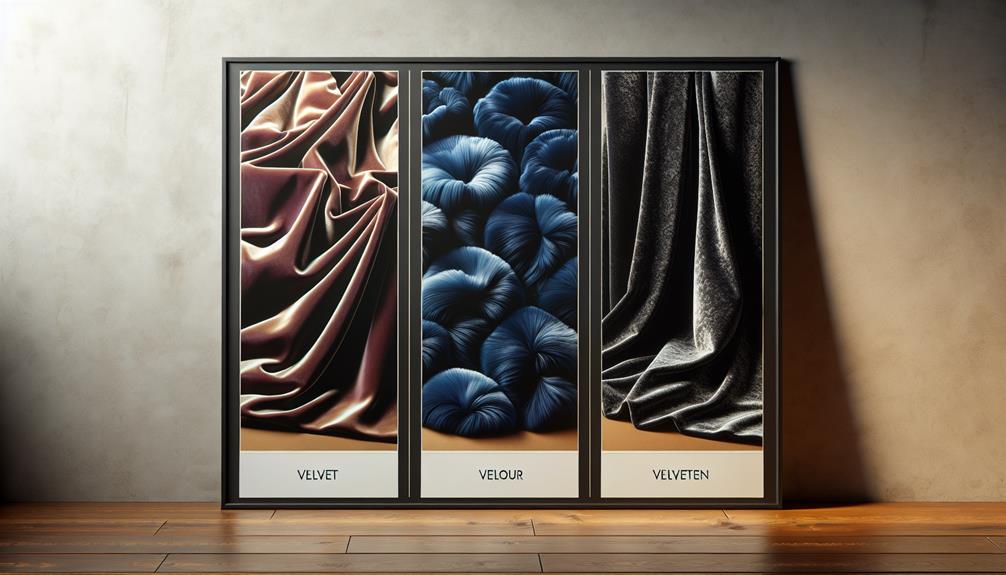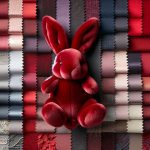When it comes to fabrics, navigating the differences between velvet, velour, and velveteen can sometimes feel like disentangling a web of intricate threads. Each material has its own unique characteristics that set it apart, from the way it drapes to the subtle sheen it reflects.
But what truly distinguishes these luxurious textiles from each other lies beneath the surface, waiting to be uncovered. Let's peel back the layers and uncover the secrets that make these fabrics so desirable in the world of fashion and beyond.
Table of Contents
Key Takeaways
- Velvet offers a rich, plush feel with a luxurious appearance and durability.
- Velour provides a soft, cozy tactile experience with good stretchiness and breathability.
- Velveteen mimics velvet's luxury at a more affordable price, suitable for intricate designs.
- Understanding the unique characteristics of each fabric is essential for creating standout fashion pieces.
Origin and History
When exploring the origin and history of velvet, velour, and velveteen, it becomes evident that each fabric has a unique background steeped in luxury and craftsmanship. Velvet, with its origins dating back to ancient times, was initially crafted from silk, making it a symbol of wealth and prestige. Over time, the evolution of velvet led to the use of other fibers like cotton and synthetics, broadening its accessibility while maintaining its luxurious reputation.
Velour, on the other hand, emerged more recently in the 19th century as a cheaper alternative to velvet. Initially made from cotton, it later incorporated synthetic fibers for increased durability and affordability. Despite its humble beginnings, velour gained cultural significance in the mid-20th century with its association with leisurewear and athletic apparel.
Velveteen, a fabric designed to mimic the luxurious appearance of velvet, has a history rooted in practicality and accessibility. Developed as a more affordable option for the masses, velveteen's evolution showcases how craftsmanship and ingenuity can democratize luxury, giving it a unique place in the cultural tapestry of textile history.
Fabric Composition
Exploring the fabric composition of velvet, velour, and velveteen reveals distinct characteristics that contribute to their unique textures and appearances. Velvet, traditionally made from silk, is now crafted from a variety of fibers like cotton, polyester, and viscose. It boasts excellent durability and colorfastness, making it a luxurious and long-lasting choice.
Velour, on the other hand, is typically composed of cotton or synthetic fibers like polyester. Known for its softness and plush feel, velour offers good stretchiness but may lack the durability of velvet. It also tends to be more breathable than velvet, providing comfort in various climates.
Velveteen, a cotton fabric finished to resemble velvet, is a durable and cost-effective alternative. While not as luxurious as velvet, velveteen offers good colorfastness and breathability. Its blend of cotton and synthetic fibers provides a balance of comfort and resilience.
Texture and Feel
Moving from fabric composition to texture and feel, one can immediately distinguish between velvet, velour, and velveteen based on their tactile qualities. Velvet, known for its luxurious touch, offers a rich and plush feel. The dense pile of velvet creates a smooth, soft surface that's incredibly pleasing to the touch, providing a sensory experience that exudes elegance and sophistication.
On the other hand, velour, with its slightly coarser texture compared to velvet, still offers a velvety feel but is often lighter and more stretchy. While not as opulent as velvet, velour provides a comfortable and cozy tactile comparison, making it a popular choice for various apparel and upholstery applications.
Velveteen, resembling velvet but with a shorter pile and a firmer hand, offers a more practical alternative with a similar look. The tactile differences between velveteen and velvet are noticeable, with velveteen having a smoother, less plush feel, yet still providing a touch of luxury in a more affordable and durable option.
Appearance and Shine
When it comes to the look and shine of velvet, velour, and velveteen, there are key differences to take into account.
Texture and softness play a significant role in how these fabrics appear and feel to the touch.
Additionally, the luster and sheen of each material can vary, affecting their overall aesthetic appeal.
Texture and Softness
I can feel the difference in texture and softness between velvet, velour, and velveteen just by running my fingers across them, noticing the variations in appearance and shine.
Velvet, known for its luxurious feel, ranks high on the softness scale due to its dense pile and smooth finish.
Velour, with a shorter pile than velvet, is also soft but tends to have a slightly more casual texture.
Velveteen, although resembling velvet, is often less plush and can have a slightly rougher feel compared to velvet and velour.
When it comes to fabric comparison and durability factor, velvet usually excels due to its tightly woven construction, making it a long-lasting choice for elegant garments and upholstery.
Luster and Sheen
With a subtle yet enchanting sheen, velvet, velour, and velveteen each possess a distinct luster that contributes to their unique aesthetic appeal. When comparing their luster and sheen, velvet stands out for its luxurious and rich appearance, reflecting light in a way that gives it a deep, almost metallic-like shine. Velour, on the other hand, has a softer sheen that is more subdued compared to velvet, offering a plush and cozy look. Velveteen falls in between the two, with a moderate sheen that adds a touch of sophistication to its appearance. This table highlights the differences in luster and sheen among velvet, velour, and velveteen:
| Fabric | Luster | Sheen |
|---|---|---|
| Velvet | Luxurious | Deep shine |
| Velour | Soft | Subdued |
| Velveteen | Moderate | Sophisticated |
Uses in Fashion
Let's talk about how each fabric is utilized in fashion and the key characteristics that set them apart.
Understanding the fabric characteristics and styling differences between velvet, velour, and velveteen can help in making informed fashion choices.
From luxurious velvet evening gowns to casual velour tracksuits, each fabric brings its own unique touch to the world of fashion.
Fabric Characteristics
When considering fabric characteristics for fashion applications, it's important to distinguish between velvet, velour, and velveteen to make informed design choices.
Velvet is known for its luxurious feel and durability, making it suitable for high-end garments. It offers a wide range of color options, allowing for versatile designs.
Velour, on the other hand, is softer and more affordable than velvet. While slightly less durable, it comes in vibrant hues, perfect for creating bold fashion statements.
Velveteen, a cotton fabric that resembles velvet, is durable like velvet but more budget-friendly. It offers a plethora of color choices and lends itself well to intricate designs.
Understanding the durability comparison, color options, price differences, and design possibilities of these fabrics is essential for creating fashion pieces that stand out.
Styling Differences
As I explore the styling differences among velvet, velour, and velveteen in fashion, their unique uses come to light, showcasing the versatility each fabric offers in creating distinct looks. When styling with these fabrics, it is crucial to think about the texture and sheen they bring to an outfit. Velvet is luxurious and often used for formal occasions, while velour gives off a more casual vibe with its plush feel. Velveteen, on the other hand, strikes a balance between the two, making it suitable for various settings. To elevate your fashion game, consider pairing velvet with metallic accents for a glamorous touch, combining velour with denim for a stylish contrast, or mixing velveteen with lace for a sophisticated look.
| Fabric | Styling Tips |
|---|---|
| Velvet | Pair with metallics for glamour. |
| Velour | Mix with denim for a casual vibe. |
| Velveteen | Combine with lace for elegance. |
Care and Maintenance
To keep your velvet, velour, or velveteen fabrics looking their best, regular gentle cleaning is essential. Here are some care and maintenance tips to guarantee the longevity of your luxurious textiles:
- Washing Instructions: Always follow the manufacturer's guidelines for washing your fabric. Hand washing or using the delicate cycle on your machine is usually recommended to guarantee damage prevention.
- Storage Tips: Store your velvet, velour, or velveteen garments in a cool, dry place away from direct sunlight to avoid fading. Hanging items on padded hangers can help maintain their shape.
- Stain Removal: Act quickly when dealing with stains on these fabrics. Blot the stain gently with a clean cloth to avoid spreading it, and consider using a gentle fabric stain remover.
- Ironing Techniques: If ironing is necessary, turn the fabric inside out and use a low heat setting. Place a cloth over the fabric to protect it from direct heat and prevent any shine from developing.
Frequently Asked Questions
Can Velvet, Velour, and Velveteen Fabrics Be Easily Dyed at Home?
Dyeing velvet, velour, and velveteen at home can be a fun, cost-effective DIY project. It allows for fabric color customization, enabling creative expression. With the right materials and techniques, achieving desired hues is achievable.
Are There Any Specific Fashion Trends or Designers Known for Using Velour in Their Collections?
In recent years, velour has gained popularity among celebrities for its luxurious feel on the red carpet. On the runway, velveteen has been a staple in haute couture collections, showcasing its versatility and elegance in high fashion.
How Does Velvet, Velour, and Velveteen Compare in Terms of Breathability and Comfort?
Breathability varies among velvet, velour, and velveteen. Velvet is less breathable due to its dense weave, while velveteen offers more air circulation. Comfort-wise, velour tends to be softer, but velvet and velveteen can provide greater durability and luxurious texture.
Are There Any Specific Cultural or Historical Significance Associated With These Fabrics?
Cultural significance and historical origins are important when understanding fabrics like velvet, velour, and velveteen. Delving into their past reveals stories of luxury, fashion evolution, and diverse uses that have shaped societies throughout time.
Can Velvet, Velour, and Velveteen Fabrics Be Easily Tailored or Altered by a Seamstress?
Working with velvet, velour, and velveteen presents unique tailoring challenges due to their varying fabric properties. While velvet may require more delicate handling, velour and velveteen can be easier to alter for a seamstress.
- Choosing the Right Fabrics for Babies - July 20, 2024
- Impact of Fabrics on Skin Health - July 20, 2024
- Benefits of Antimicrobial Fabrics - July 20, 2024







